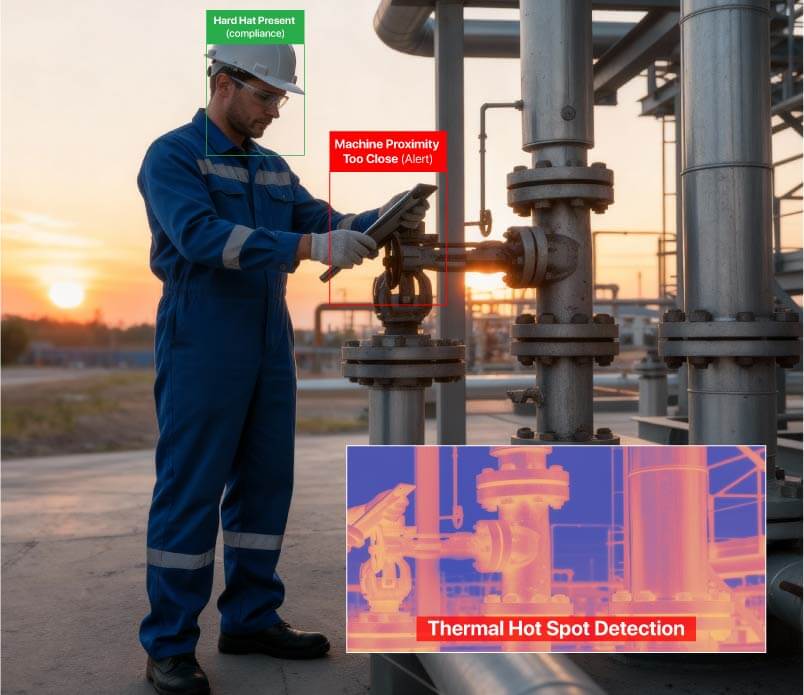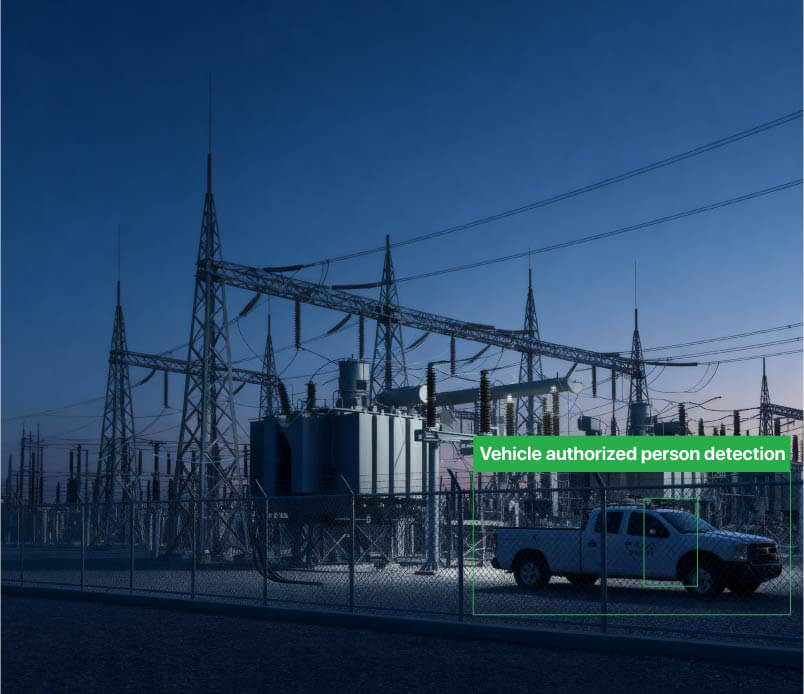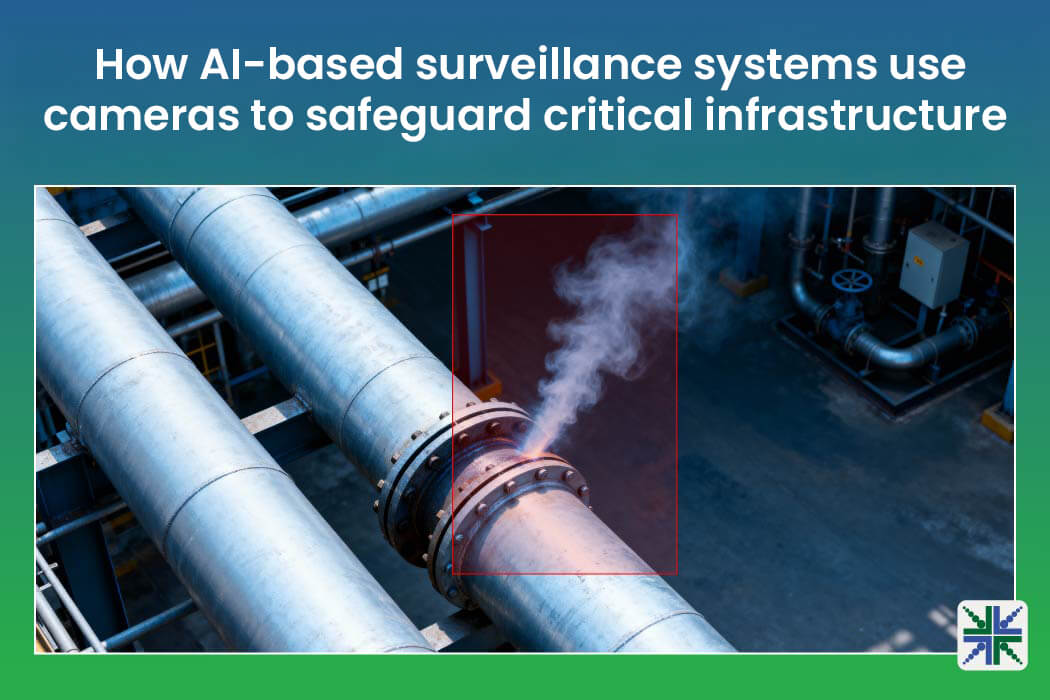Critical infrastructure runs on consistency. Energy facilities, ports, and transit networks must operate under constant oversight to stay secure. Yet monitoring such vast and exposed environments brings high data volume, unpredictable lighting, and complex access control.
AI-enabled surveillance cameras address those conditions through embedded vision processing at the edge, reducing reliance on central servers. They interpret activity as it happens, distinguish objects such as people and vehicles, and deliver alerts before an operator can react. Local inference also reduces latency and bandwidth needs while sustaining continuous awareness.
AI surveillance supports faster decision cycles, tighter compliance, and stronger safety outcomes across large-scale infrastructure by turning visual data into usable intelligence.
In this blog, you’ll get insights into how embedded cameras strengthen protection, improve analytics, support compliance, and improve safety at critical sites.
How AI Cameras Reinforce Physical Security in Critical Sites
From passive monitoring to proactive detection
Power stations, oil and gas units, pipelines, and transit terminals face diverse threats ranging from intrusion to equipment tampering. AI cameras extend protection by identifying suspicious movement, using object and attribute metadata for rapid search and alerting, and distinguishing between authorized and unauthorized personnel.
Instead of relying on centralized review, AI cameras perform inference at the edge. It means the camera runs analytics locally, generates events in real time, and forwards metadata for alerting and forensic search. With local decision-making, on-site teams receive early warnings that guide faster incident control.

 PTZ (Pan-Tilt-Zoom) cameras enable wide-area coverage by automatically tracking moving subjects across large zones such as oil and gas units, substations, and transit yards—further strengthening proactive detection.
PTZ (Pan-Tilt-Zoom) cameras enable wide-area coverage by automatically tracking moving subjects across large zones such as oil and gas units, substations, and transit yards—further strengthening proactive detection.
Situational awareness for large sites
Across expansive yards and substations, metadata-driven search and time-sync across feeds help operators trace movement origin and path, reducing manual scrubbing. The result is a perimeter that aligns with changing site layouts or schedules. With ONVIF-compliant cameras, AI-enabled systems integrate easily into current VMS/NVR platforms, allowing organizations to enhance their monitoring capabilities without needing to replace established setups.
Detection in dynamic environments
Infrastructure zones rarely stay static. Vehicle routes, construction layouts, and lighting conditions change frequently. Instead of open-ended “continuous learning” AI-based surveillance cameras use configurable analytics and scene metadata tuned to site conditions to maintain classification accuracy and reduce false alerts.
How e-con Systems helped build a multi-purpose HDR camera for smart surveillance?
Imaging Insights to Strengthen Security and Compliance
AI-driven cameras now assess how people, materials, and vehicles move through industrial environments. The continuous observation turns standard monitoring into a steady flow of operational intelligence.
Pattern recognition
AI imaging systems analyze routine visual sequences to learn standard workflow behavior over time. When deviations such as irregular routes or idle equipment appear, they trigger alerts for inspection or preventive maintenance. So, operators can maintain continuity while reducing unexpected slowdowns or stoppages.
Occupancy mapping
AI cameras equipped with analytics measure human or vehicle density across monitored zones. They create heat maps that reveal high-traffic or congested areas, equipping teams to plan better routing and access control. These insights also support layout optimization and scheduling for safer movement of people and assets.
Event correlation
Imaging data from surveillance cameras links each detected motion, entry, or activity to operational timestamps within centralized dashboards. Cross-referencing events with logs or process data ensures operators can identify causes of slowdowns or safety breaches.
Predictive modeling
Metadata dashboards collect recurring visual trends from site operations and environmental conditions. Analytics highlight when and where incidents, crowding, or machine delays tend to occur. These forecasts guide maintenance planning, staffing allocation, and workflow adjustments that reduce downtime risk.
Read: Transforming Railway Safety with AI Vision Cameras for Real-Time Monitoring
Driving Compliance and Incident Investigation with Vision
- Each frame includes timestamps, camera ID, and positional data for traceable documentation.
- Evidence-lock and retention controls protect selected recordings from deletion, preserving authenticity for audits and insurance reviews.
- AI analytics categorize video by object type, motion, and event tags, enabling rapid evidence retrieval during investigations.
- Time-synced metadata supports reconstruction of activity across multiple entry points and zones, enabling clear sequence validation.
- Built-in analytics convert movement frequency into heat maps for pattern analysis and zone planning.
- Video management systems mark and protect important recordings so they aren’t overwritten, ensuring they remain available for audits or investigations.
- Digital signatures and supervised export features preserve data integrity for regulatory or legal submissions.
- Video and metadata are stored under defined encryption standards to maintain chain-of-custody integrity.
Read: What Are the Top Applications of AI Cameras in Modern Security and Surveillance?
How AI Imaging Enhances Workforce and Equipment Safety
AI imaging strengthens workforce safety by identifying unsafe conditions before they escalate. Cameras track motion around machinery, verify PPE items such as hard hats and high-visibility vests, and supervise entry into restricted areas. By processing visuals locally, they deliver instant alerts to on-site teams, turning daily monitoring into active prevention.
Here’s a brief look at what AI surveillance cameras can do for workplace safety:
- PPE validation: Confirms helmet, vest, and glove compliance in dynamic environments
- Zone intrusion alerts: Detects unauthorized movement near operational or hazardous areas
- Machine proximity detection: Reframes as zone-based presence and line-crossing analytics around machinery to manage separation
- Crowd flow monitoring: Uses people-counting and queue/loiter analytics to support evacuation procedures and route guidance
Low-light observation for preventive safety
Hazardous infrastructure rarely operates under ideal lighting or temperature conditions. Smart Near-Infrared (NIR) cameras are essential for maintaining continuous visual awareness when light fails. These cameras cut through darkness, fog, or glare-prone scenes to keep critical footage usable in tunnels, offshore decks, and enclosed spaces. Their enhanced visibility supports preventive maintenance scheduling and improves the accuracy of post-event reviews.
Read: What Challenges Can Our 4K HDR GigE Camera Solve for Industrial Surveillance?
e-con Systems’ High-Quality Cameras for Infrastructure Surveillance
Since 2003, e-con Systems has been designing, developing, and manufacturing OEM cameras. Our smart surveillance cameras deliver consistent, high-quality imaging with built-in analytics for a wide range of security applications. They are certified for industrial-grade reliability, aligning with global and regional standards such as ONVIF, NDAA, TAA, UL CAP, and STQC.
Check out all our camera solutions for smart surveillance
Use e-con Systems’ Camera Selector to explore our end-to-end portfolio.
Need a seasoned imaging specialist to recommend the right camera for your surveillance use case? Email camerasolutions@e-consystems.com, and our team will respond with options and a quick path to evaluation.
FAQs
How do AI-enabled cameras help secure large critical infrastructure sites?
AI cameras perform real-time analysis at the edge to detect movement, recognize vehicles or people, and trigger alerts before manual review is needed. The edge processing minimizes delay, reduces network strain, and ensures continuous visibility across expansive facilities.
What advantages do metadata-driven imaging systems provide?
Metadata adds context, such as object type, timestamp, and position, to the recorded frames. It lets operators search video quickly, reconstruct events across multiple feeds, and verify activities for compliance or forensic investigations.
How does AI imaging improve safety for on-site personnel?
Cameras equipped with PPE and zone analytics verify helmet or vest use, detect entry into restricted zones, and track proximity to moving equipment. These capabilities generate immediate alerts that help prevent accidents and reinforce safe operating practices.
Why are thermal and low-light cameras important in industrial environments?
Thermal imaging detects overheating components, fluid leaks, or electrical faults in conditions where normal visibility fails. Low-light cameras maintain clarity in tunnels, offshore decks, or night operations, providing continuous coverage for inspection and maintenance.
Which compliance and security standards do e-con Systems’ surveillance cameras support?
e-con Systems’ cameras meet international frameworks such as ONVIF, NDAA, TAA, UL CAP, and STQC. It ensures interoperability, cybersecurity assurance, and eligibility for regulated industrial and government installations.

Ram Prasad is a Camera Solution Architect with over 12 years of experience in embedded product development, technical architecture, and delivering vision-based solution. He has been instrumental in enabling 100+ customers across diverse industries to integrate the right imaging technologies into their products. His expertise spans a wide range of applications, including smart surveillance, precision agriculture, industrial automation, and mobility solutions. Ram’s deep understanding of embedded vision systems has helped companies accelerate innovation and build reliable, future-ready products.




